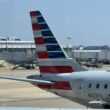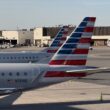This past Thursday, Global Airlines chartered its first Airbus A380 flight across the Atlantic from London Gatwick to New York JFK. Despite difficulties, challenges, and many voices of doubt from across the aviation industry over the past few years, they managed to get an A380 into the sky. That’s an accomplishment, no matter the circumstances.
With that said, there are still many questions the airline and CEO James Asquith have to face moving forward, and the initial reviews that came out of the inaugural were rather interesting.
I talked with Gabe Leigh for this piece, Flightradar24‘s senior content producer, who was on the inaugural. He flew in economy class, and offered me some insights regarding both the hard and soft products on the A380, in addition to his thoughts on the experience overall.
Let’s go over his comments first before I talk about the logistics and operations.
Inaugural Details
To start, let’s remember that this inaugural flight is hardly the final product if Global does operate more flights in the future. Some parts may improve, while other parts may be cut back. We’ll see if it ever happens.
Here are some details from the inaugural flight:
The flight had 95 passengers onboard, which is obviously minuscule considering the capacity of an A380. Unless Global shuffled things around a bit (which I doubt they did), this China Southern configuration has 506 seats onboard, with 8 First, 70 business, and 428 economy seats. The flight was chartered by Hi Fly.
Gabe said that almost all passengers were on the upper deck, aside from the few who were in First. A small economy section is on the back end of the upper deck, and that’s where all the economy class passengers were. He noted that the majority of passengers were in business, and that less than 40 or so passengers were in economy.
The seat selection situation sounded interesting. “I wasn’t able to do it when I booked,” Gabe said. “I did hear that some people were able to do seat selection at booking; I was just assigned a seat at random.” Remember that Global Airlines did not sell the tickets since they aren’t yet an airline. Tickets were sold by TravelOpedia.
Check-in and boarding had their typical celebratory feel to them for an inaugural flight, with balloons and decorations. He did note that boarding was a bit more disorganized and began late.
Gabe also added something interesting with regard to the Hi Fly flight attendants. “It turns out that they have 5 people in that crew that are dedicated Global Airlines crew.” I’m guessing Global Airlines pays for these dedicated crews also? But like with many things with this airline, I don’t exactly see how this makes financial sense.
Food Service, Hard Product
The economy class food seemed solid to me, judging by photos circulating online. Maybe they could’ve been presented in a better way, but it’s still a notable difference from what’s offered by other airlines on transatlantic routes.
“Everyone had a little bit of an elevated thing,” Gabe said. It was “Economy tray service, but it was quite good, tasty food.” He added that it’s “definitely superior to anything you’d get on other transatlantic flights.”
The service did seem to take long, both from seeing other reviews and talking with Gabe. “They took a long time to get the lunch out, it was about 2 hours before we really got served.” There were two meals, meaning that they only had about 2 hours between each meal because it was just a 6 hour flight.
Amenity kits and Global Airlines branded items were also offered on each seat, but he also noted that he can’t imagine this is what they’re planning to offer on potential routine flights.
Meanwhile, Global Airlines did not seem to impress with its seats. “The seats weren’t in the best condition, they felt old. The seatback was hard, some people’s headrests were falling off in economy. There were other bits and pieces like a thing on the overhead panel that was hanging down. Nothing that I would say was awful, but it wasn’t a brand new cabin in great shape. You could see the bones of the seat through a gap in the fabric.” He added that he wouldn’t want to do an overnight on that seat, and neither would I!
However, I do see what Global is trying to aim for (at least in economy), with bringing the “golden age” of air travel back. Gabe gave a nod to this point, saying that “it’s something from a bygone era.” The airline still has a fair amount of improvements to put together to deliver on this, but I see what they’re trying to do with the higher quality meals and selections of alcoholic beverages and champagne.
If you haven’t yet, your next task after you finish reading this story is to watch his video on Flightradar24’s YouTube channel.
You can also find more of Gabe’s content on his Instagram and his own YouTube channel.
Can This Be Sustained?
Global Airlines hasn’t revealed any long-term plans on what they’re going to do after these initial flights. I see this inaugural flight, along with its other series of flights, as a means of attention grabbing to raise funds and attract interest.
The company likely lost money with this flight on Thursday. In addition to the small number of passengers, capital costs related to operating an A380, and fuel costs, parking costs at JFK Airport would’ve been incredibly costly, as the plane sat there for a few days.
That said, there’s one area that I want to touch on where I think Global will have a hard time filling seats if they were to run a scheduled operation.
Capturing Demand vs. Creating Demand
Global has shared that they plan to fly from London to New York and Los Angeles. These are very, very high demand routes already served by some of the largest and strongest airlines in the world with deep alliances and codeshare agreements. Trying to jump headfirst into a market like this is a challenge.
What this company is trying to do here is to capture demand. Demand on these routes is already established; they’re one of the busiest in the world, and many passengers already have loyalty to an airline.
The truth is, it’s difficult to reel in a portion of these passengers and operate profitably. Factor in loyalty, connections, and convenience, and passengers don’t have much of an incentive to hop on Global Airlines. The onboard product could be a potential motivation, considering the company’s vision to bring back the “golden age” of air travel. The airline has a ways to go though, to have any of that make sense for a transatlantic passenger.
Let’s say I was flying from Budapest, Hungary, back to New York City. There are no direct flights between the two cities, so I would have to make a connection somewhere anyway. If I wanted to make a Global Airlines flight work here, I would have to ferry myself to London on another airline and ticket, and book the Global Airlines ticket separately. Add in the fact that I’ve been with the AAdvantage program my entire life, there isn’t really a reason for me to do a Global Airlines flight just because I may get a bit of a better inflight experience in economy.
Maybe I’d do it if Global Airlines tickets were far cheaper than what American Airlines/British Airways would be offering, but is a low-cost carrier what the company is really going for?
With that said, it may be a different story if Global Airlines were going to fly an underserved market, such as a leisure destination that currently does not have a lot of competition. This is called creating demand. Instead of trying to reel in passengers from other airlines in an existing market, they can attract customers who wouldn’t have flown a certain route because of inconvenience, but now will since an airline is operating it.
This is how Ryanair, one of the most profitable airlines in the world, does it. They don’t focus on high-demand routes like London to Paris or Barcelona to Madrid. Instead, they create their own demand by flying routes underserved by the full service airlines (there are exceptions to this, of course). But remember, Global Airlines is doing this with an Airbus A380, not an E jet or even a Boeing 737. We’re talking about a huge number of seats to fill here.
Of course, we don’t really know what the airline is going for yet. Gabe even said that the airline told them that “it’s not the real, final product,” but also noted that “…we have to evaluate it based on what we saw because that’s what they offered.” Who knows what changes we could see from them, whether that’s in a good or bad direction.
Concluding Thoughts
This is my long explanation for saying that I still have many questions about Global. I see the vision of bringing back the “golden age” of air travel with champagne and quality meals, but there are still many question marks regarding its operations and where the funding is coming from. I also think its onboard product, and maybe even its network, need to be reevaluated if the company wants to move ahead with this project.
Either way, it was cool to see this inaugural flight actually happen. As I said in the beginning, it’s undoubtedly an accomplishment to get to this point of getting an A380 into the sky. Any start-up airline is a challenge, and Global’s unique approach to many things makes it all the more interesting. We’ll see what the future holds for this company.
It was also fun to hear Gabe’s experience on the inaugural. I appreciated his open-minded approach as he went about this flight. As I said earlier, check out his and Flightradar24’s YouTube video!
Featured image via Wikipedia Commons.









